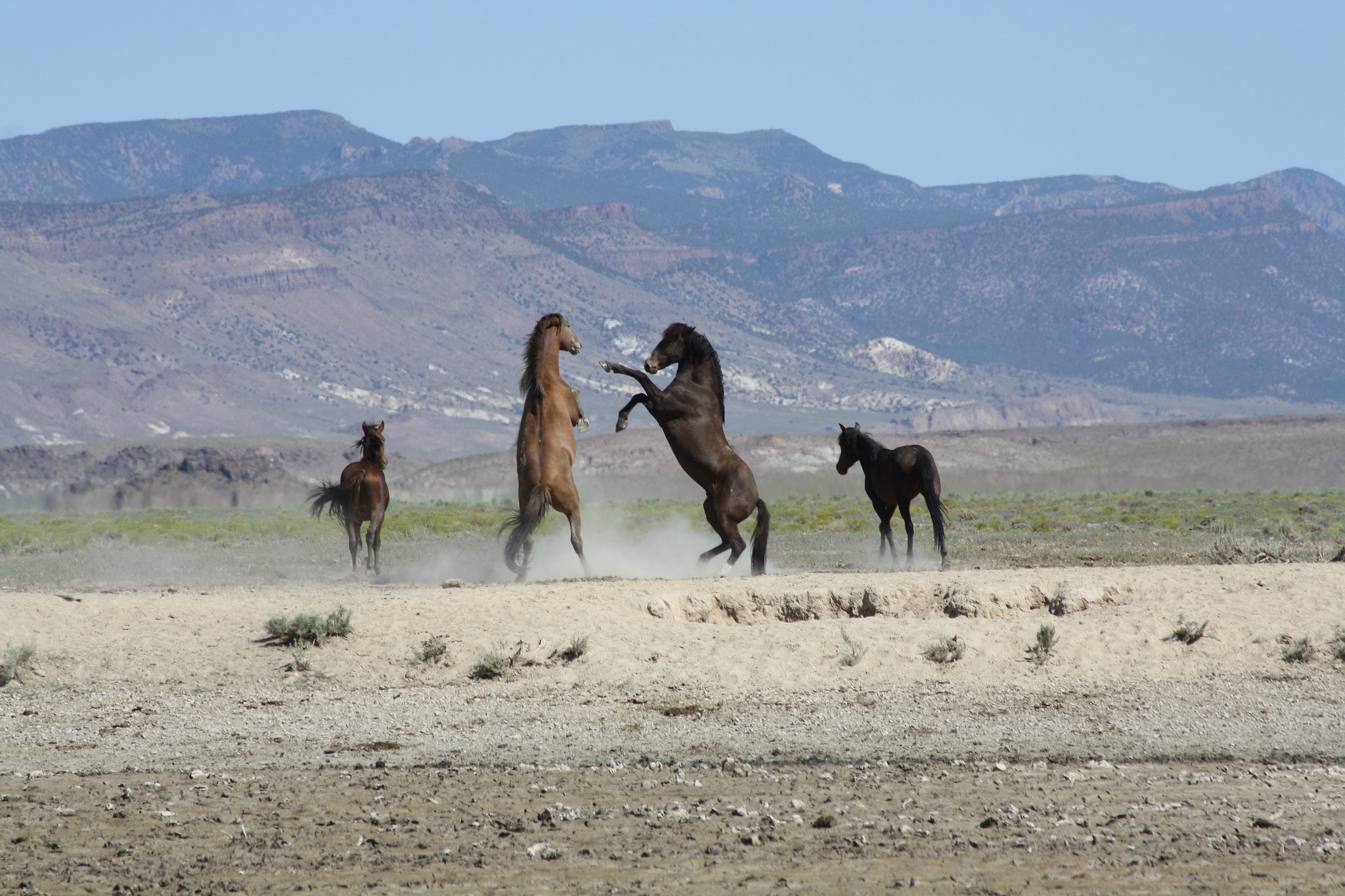Indy Environment: Wild horse panel convened to ‘keep the search for a solution alive’

Good morning, and welcome to the Indy Environment newsletter. I'm Amy Alonzo, the environment reporter for The Indy.
Last week, I was preparing to leave on an overnight work trip to the proposed site of the Rhyolite Ridge lithium mine in Southern Nevada when I was notified of a wild horse panel scheduled for the same time in South Reno.
It was neither the first or last panel discussion to be held on the issue — this was the second I’d covered in less than six months for The Indy — but it was notable because it included not just ranchers, horse advocates and state lawmakers but also leadership from the Nevada State Office of the Bureau of Land Management and the Nevada Department of Wildlife. In several years of writing about wild horses, the agencies’ leadership have generally been loath to take sides on the issue.
I switched gears, making a 14-hour round-trip trek to the mine site in one day so I could attend the panel. Its location in South Reno was fitting — the area boasts one of the largest concentrations of wild horses near an urban area in the state, although some people argue the Virginia Range horses, managed by the state and not the federal government, are not true wild horses due to the supplementary feed and water they receive and their comfort around humans.
The event drew heated comments from the panel and the audience as polarizing ideas were batted around, but at the end of the evening, the only thing that was clear is that we’re just as far from a solution as we’ve ever been.
As always, we want to hear from readers. Let us know what you’re seeing on the ground and how policies are affecting you. Email tips to me at [email protected]. To get this newsletter in your inbox, subscribe here.

What do a state lawmaker, federal land use manager, wildlife advocate, biologist, rancher and animal activist have in common?
Not much, it turns out, when it comes to agreeing on how to address Nevada’s swelling wild horse population.
There are about 90,000 wild horses nationwide. More than half — about 50,000 — are in Nevada. The state can sustain a population of around 20,000, according to public land use managers.
The diverse group of speakers gathered Friday in South Reno for a panel discussion hosted by the Nevada Lands Council, offering insight into how Nevada’s wild horses affect the state and its wildlife, and what solutions could be implemented to reduce the numbers of horses on the range and in holding facilities.
Elko County Commissioner Rex Steninger, director of the Nevada Lands Council and moderator of Friday’s panel, said the issue of too many horses has been discussed in many roundtables, papers and debates, but the “problem is still with us. We have scheduled this event to keep the search for a solution alive.”
The solutions pitched by the panelists highlight the challenge facing lawmakers and land use managers tackling the issue — there are about as many ideas of how to address the conundrum as there are wild horses in the state.
Sen. Ira Hansen (R-Sparks) said appropriate funding needs to be allocated to state and federal Bureau of Land Management (BLM) offices to increase the number of horses that are rounded up each year.
Tina Nappe with the Coalition of Healthy Nevada Lands, Wildlife and Free-Roaming Horses suggested wild horse advocacy groups care for the excess horses that are in captivity. As of February 2023, there were more than 60,000 wild horses in federal holding facilities awaiting adoption. American taxpayers spend about $45,000 per horse in captivity to care for it over its lifetime if it isn’t adopted after a roundup.
Activist Scott Beckstead countered that instead of being kept in holding pens, those horses should instead be reintroduced to the wild.
Rounding out the panel were Nevada State BLM Director Jon Raby, Nevada Department of Wildlife Deputy Director Caleb McAdoo and Elko County rancher Ken Jones, each of whom offered divergent ideas.
It wasn’t the first time Hansen and Beckstead have squared off — the two faced each other in a September debate in Elko.
Read More: ‘Ecologic catastrophe’ or ‘government gaslighting?’ Senator, activist debate wild horses
But the addition of Raby and McAdoo to the panel was notable. While neither offered any groundbreaking comments about the equines, their presence lent a different flavor to the panel.

The only idea that unites both sides
Federal land managers have wrestled with how to address the wild horse situation for decades.
In 1971, Congress authorized federal land managers to protect and manage wild horses and burros as part of the nation’s public lands “in a manner that is designed to achieve and maintain a thriving natural ecological balance” under the Wild Free-Roaming Horse and Burro Act of 1971.
The Public Rangelands Improvement Act of 1978 expanded on that, authorizing the removal of excess animals from the range to restore ecological balance and protect the range from the deterioration associated with overpopulation.
In the years since, as the number of horses in federal holding pens has swelled along with populations on the rangeland, various lawmakers have proposed bills that would drastically alter the way the horses are managed, such as the failed bill in 2018 by Rep. Chris Stewart (R-Utah) that would have allowed the euthanization of thousands of wild horses and burros as a last-ditch effort to control populations, or last year’s Wild Horse and Burro Protection Act of 2023, introduced by Rep. Dina Titus (D-NV), that would have banned the use of helicopters in roundups.
Read More: ‘It will never end’: Long a symbol of the West, debate rages over wild horse management
With federal lawmakers dragging their heels to pass any meaningful legislation on either side of the issue, the BLM’s Nevada State Office in 2021 developed a five-year plan to achieve appropriate management levels to at least address the population issues in the state.
According to the plan, about 15,000 horses must be removed annually to reach appropriate management levels within five years; 11,300 must be removed annually to reach appropriate levels within 10 years; or 10,000 must be removed annually to reach appropriate levels over 20 years.
The target numbers are aggressive because the state is home to thousands more horses than it can sustain and wild horse populations can double in size every four to five years.
“The gathering of horses does not keep pace with their reproduction,” Nappe said.
Since October 2023, about 7,200 horses have been gathered on federal lands in Nevada, with fertility control measures implemented on 290 mares, according to Raby. Another 3,600 horses are scheduled to be gathered this year.
Nationally, about 20,000 horses need to be rounded up each year over the next decade to reach appropriate management levels, according to Raby.
Those appropriate management levels — which vary from location to location across the various states wild horses and burros call home — are “politically contrived,” countered Beckstead. Those numbers should be updated and adaptable, he said.
Steninger kept the panelists on track as they debated the impacts of livestock versus horses on the rangeland while silencing hoots and applause from segments of the crowd of about 100 people in attendance.
As the discussion wrapped up, Steninger posed a question — submitted by one of the audience members — that finally united the panelists.
Has hunting wild horses been considered as a way to lower wild horse numbers?
“Certainly not for the BLM,” Raby said, as the others concurred. “We have other solutions to focus on.”
The question remains though — which solution?

Here’s what else I’m watching this week:
Illegal trails aren’t a new issue — but they’re an important one for recreationalists and land use managers. More from the Las Vegas Review-Journal.
A guide to the periodic table of the elements, as it pertains to mineral extraction in Nevada, from the Sierra Nevada Ally.
A bit of lighthearted reading in a compilation of one-star national park reviews gathered by The Washington Post.
NV Energy’s proposed Greenlink transmission project is already over budget — and it hasn’t even been permitted yet. More in the Las Vegas Review-Journal.
